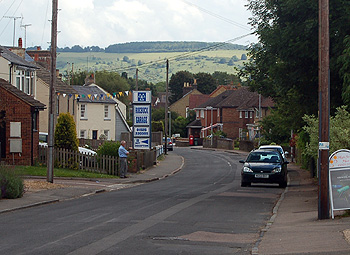The Parish of Eaton Bray in General

The view from Eaton Bray church March 2012
Landscape
Eaton Bray lies at the foot of the Dunstable Downs, themselves part of the Chilterns. As might be expected some of the soil is chalky but the picture is more complex than that. The area around Elachi, the former Plough Public House as well as Valance End, now in Whipsnade, for example has an underlying geology which comprises a mixture of West Melbury Marly Chalk Formation, laid down between 94 and 99 million years ago in the Cretaceous Period and Zig Zag Chalk Formation laid down at the same time.
The southern part of Moor End, is also West Melbury Marly Chalk Formation but with a sub soil called head, a mixture of clay, silt sand, gravel deposited by the watercourses in the area. The northern part of Moor End as well as Bower Lane, Dunstable Road and Harling Road is all West Melbury formation with a chalky subsoil but the south-east side of the High Street has solid geology called Upper Greensand Formation, a mixture of siltstone and mudstone laid down between 94 and 112 million years ago. The Market Place, Church Lane and Northall Road also lies on this formation but with head, once more, as the subsoil. Finally Totternhoe Road, the Rye and the northern part of the parish lies on a fourth type of solid geology – Gault Formation, a mudstone laid down between 99 and 112 million years ago.
The church stands around 330 feet above sea-level whilst the Recreation Ground is ten feet or so lower. Rye Farm is lower still at around 305 feet whilst Honeywicke Cottage stands at about 327 ft. The former Moor End Mill is around 322 feet above sea-level but the highest parts of the parish are towards the Chilterns - Café Masala stands about 350 feet above sea-level, Bellows Mill around 337 feet, Doolittle Mill nearly 370 feet with Elachi at 418 feet above sea-level with Edlesborough Hill standing at 434 feet..
Volume III of The Victoria County History for Bedfordshire was published in 1912, before a series of boundary changes which have had a cumulative effect of making today’s parish slightly smaller. Then the parish comprised 2,417 acres of which more than half was arable, with 664 acres of “rich meadows for cattle grazing”. Crops were wheat, barley, beans, plums (usually for prunes) and damsons. The Victoria County History remarked: “Duck rearing was also started about twenty or thirty years ago and is still kept up by many of the natives, but the risks being so great it is gradually losing its popularity”. In fact evidence from Quarter Sessions records shows that duck rearing was popular as far back as the 1830s.

Name
The word Eaton means “river farm”. Eaton Bray has numerous small streams giving the name the connotations of a well-watered landscape. The Bray element was not added until the 15th century or later, the Bray family becoming Lords of the Manor of Eaton in 1490. The first element of the name has changed through history as the table below demonstrates:
- Eiton: 1086-1286;
- Eitona: 1086-1286;
- Eitun: 1156;
- Æiton: 1159;
- Etton: 1164;
- Ehton: 1166;
- Eyton: 1220-1491
- Eton: 1241-1490.

The Village Hall July 2012
Administrative History
Eaton Bray is an ancient parish in the Manshead Hundred. It was, briefly, the centre of a rural district council from 1894 to 1933. The parish is bordered as follows: Billington to the north; Stanbridge to the north-east; Totternhoe to the north-east and east; Whipsnade to the south and south-east and Edlesborough [Buckinghamshire] to the west and south-west. There have, of course, been small boundary changes over the years, the most significant of which was the adjustment of the county boundary with Buckinghamshire to run along the stream in Moor End meaning that Moor End Mill, Two Counties Mill and Summerly Road, amongst others, moved from Eaton Bray and Bedfordshire to Edlesborough and Buckinghamshire.
In 1985 an area of land running north from Dukes Avenue in Whipsnade was transferred from Eaton Bray to Whipsnade. Some small, uninhabited areas were also exchanged between Eaton Bray and Totternhoe [MCDP87/5].

View south-east along the High Street July 2012
Population
The Domesday Book of 1086 records 20 villagers, 13 smallholders and 2 slaves in the Manor of Eaton Bray – a total of 35. These numbers would only count the heads of households so to arrive at a true figure for the population one needs to multiply this figure by at least four, suggesting a total population of around 140, making Eaton Bray a more substantial settlement for the time.
It looks as if Eaton Bray has always been one of the more populous rural parishes in the county as the figures below indicate. It is interesting to note that the only drop in population occurred after 1871 and lasted into the 1920s. An agricultural depression initially drive people away from the land to seek their living in towns and steady agricultural mechanisation continued that trend before an increasing birth rate began to reverse the decline. Latterly, of course, many villages have seen great expansion as the population has risen and people who work in towns and cities have chosen to move to the countryside for the better quality of life it affords; hence the population of Eaton Bray more than doubling between 1931 and 2011.
- 1801: 583;
- 1811: 674;
- 1821: 816;
- 1831: 957;
- 1841: 1,097;
- 1851: 1,455;
- 1861: 1,440;
- 1871: 1,640;
- 1881: 1,520;
- 1891: 1,330;
- 1901: 1,117;
- 1911: 979;
- 1921: 975;
- 1931: 1,042;
- 1951: 1,165;
- 1961: 1,509;
- 1971: 1,671;
- 1981: 2,072;
- 1991: 2,300;
- 2001: 2,591;
- 2011: 2,585.